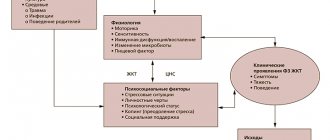Obsessive compulsive disorder is a mental disorder in which the patient experiences obsessive thoughts. They arise against the will of man. To reduce the level of anxiety, a person performs certain actions.
What is compulsive obsessive personality disorder?
According to ICD 10, obsessive compulsive disorder is defined as repetitive obsessive thoughts or compulsions. Thoughts manifest themselves in the form of images, ideas and motivations that constantly come to a person’s mind in the form of stereotypes. In most cases, they are upsetting, so the patient tries to resist them, but this does not bring the desired result. The patient himself does not determine the disgusting and involuntary nature of his thoughts.
Obsessive behavior manifests itself in the form of stereotypical mannerisms that people constantly repeat. They do not allow useful tasks to be performed and do not bring pleasure to the patient. A patient with pathology performs actions to prevent bad events that, in his opinion, will happen soon. The patient believes that the actions are meaningless and ineffective and tries to repeat them. The pathological process is accompanied by constant anxiety. When compulsive actions are suppressed, an increase in anxiety is observed.
Treatment of OCD (Obsessive-Compulsive Disorder) and Obsessive Thoughts
Initial consultation by phone is free!
Psychiatric examination: +7 495 741–94–64
Obsessive-compulsive disorder (OCD) is characterized by the presence of recurrent, persistent, unwanted and intrusive thoughts, urges or images (obsessions) and/or repetitive behaviors or mental actions that patients feel an urgent need to perform (compulsions) to try to reduce or prevent anxiety , which is caused by obsessions. The diagnosis is made based on the medical history. Treatment for OCD consists of psychotherapy (namely exposure and response prevention techniques), drug therapy (namely SSRIs—selective serotonin reuptake inhibitors—or clomipramine), or, in particularly severe cases, both.
OCD is slightly more common among women than men, with a prevalence of approximately 1 to 2% of the population. The average age of onset of OCD is 19–20 years; In approximately 25% of cases, the onset of OCD is observed by age 14. Up to 30% of people with OCD also have or are suffering from a tic disorder.
Clinical manifestations of OCD
Obsessions are unwanted, intrusive thoughts, urges, or images, the presence of which typically causes significant discomfort or anxiety. The dominant theme of intrusive thoughts may be harm or risk to self and others, danger, contamination, doubt, loss, or aggression. For example, patients may be haunted by thoughts of contracting bacteria from dirt if they do not wash their hands every 2 hours or more often. Obsessions are unpleasant for the patient. Therefore, patients try to ignore and/or suppress these thoughts, urges, or images. Or neutralize them by committing compulsions.
Compulsions (often called “rituals”) are excessive, repetitive, goal-oriented behaviors that sufferers feel an urgent need to engage in to prevent or reduce the anxiety caused by intrusive thoughts, or to neutralize the intrusive thoughts themselves. Examples:
- Washing (eg, hand washing, showering)
- Checking (for example, if the stove is turned off, if the doors are locked)
- Counting (for example, repeating a certain behavior a number of times)
- Organizing (for example, organizing your desk or kitchen utensils in a specific pattern)
Most rituals, such as washing hands or checking locks, are obvious, but some rituals, such as silent calculations or silent statements, go unnoticed by others. Typically, compulsive rituals must be performed in a certain way and strictly according to strict rules. Rituals may or may not actually be associated with the feared event. If they are truly related (eg, bathing to be clean, checking the stove to prevent a fire), then the compulsions are clearly excessive: for example, the patient showers for many hours every day or checks 30 times before leaving the house. whether the stove is turned off. In any case, the obsessions and/or compulsions must be time-consuming (eg, > 1 h/day, often much more) or cause the patient significant discomfort or difficulty in functioning in various areas; in their extreme forms, obsessions and compulsions can lead to disability.
The extent to which patients understand their own problems varies. Most people with OCD admit to some degree that the beliefs underlying their obsessions are unrealistic (for example, that they won't actually get cancer if they touch an ashtray). However, sometimes understanding is completely absent (ie, patients believe that the beliefs underlying their obsessions are true and that their compulsions are reasonable).
People with this disorder may fear awkward situations or social judgment, so they often hide their obsessions and rituals. Relationships may be damaged, and performance at school or productivity at work may decline. Depression is a common secondary symptom.
Many people with OCD have co-occurring mental disorders, including
- Anxiety disorders (76%)
- Depressive disorder or bipolar disorder (63%; most common is major depressive disorder [41%])
- Anancastic personality disorder (23-32%)
About half of people with OCD have suicidal thoughts at some point, and a quarter of them attempt suicide. The risk of attempting suicide increases if people also have clinical depression.
Diagnosis of OCD
- Clinical criteria
The diagnosis of obsessive-compulsive disorder is clinical, based on the presence of obsessions, compulsions, or both. Obsessions or compulsions must be time consuming (eg, > 1 hour per day) or cause clinically significant discomfort or problems with functioning.
Treatment of OCD
- Body-Focused Therapy and Ritual Prevention Therapy
- SSRI or clomipramine
Exposure therapy and ritual avoidance therapy are often effective in patients with obsessive-compulsive disorder; their most important element is gradually increasing contact with situations or people that cause anxious obsessions and rituals, while contact is accompanied by a request not to perform these rituals. For example, a patient with a soiling obsession and a hand-washing obsession might be asked to touch the toilet seat without subsequently washing their hands. This approach reduces exposure-induced anxiety through habituation. Remission can persist for many years, especially in patients who use psychotherapeutic skills even after the formal end of treatment. However, some patients have an incomplete response to therapy (as some do to drugs).
Cognitive therapy techniques may also be effective in combating some OCD symptoms.
SSRIs and the drug clomipramine (a tricyclic antidepressant with potent serotonergic effects) are often very effective. Patients often require higher doses than typically used for depression and most anxiety disorders. Many experts consider the best treatment to be a combination of exposure therapy and ritual avoidance therapy with drug therapy, especially in severe cases.
Key points
- Obsessions are intrusive, unwanted thoughts, images, or urges that typically cause significant discomfort or anxiety.
- Compulsions are excessive, repetitive rituals that people feel compelled to perform in order to reduce the anxiety caused by their obsessive thoughts or to neutralize their obsessions.
- Obsessions and/or compulsions must be time consuming (eg, > 1 hour/day, often much more) or cause significant distress or impairment to patients.
- Treatment of OCD consists of gradually increasing contact of patients with situations that cause anxious obsessions and rituals; this contact is accompanied by the requirement not to perform these rituals.
- Taking an SSRI or clomipramine may also help.
Symptoms of obsessive compulsive disorder
With pathology, patients experience the occurrence of corresponding symptoms. Patients complain of the occurrence of repeated thoughts, desires or images that are difficult to get rid of. A person perceives them as undesirable, which leads to fear and anxiety.
The patient tries to ignore emerging desires, thoughts and images. To do this, he uses other actions, rituals and thoughts. This provides temporary relief, but does not provide a solution to the problem. Obsessive thoughts appear in the form of:
- Fear of windows, doors, and plumbing taps being left open;
- When contacting objects and people, a person develops a fear of contamination;
- After leaving home, a person worries about whether he turned off the gas stove or plumbing fixtures;
- An obsessive desire to disseminate information that could harm the patient himself, those around him and his loved ones;
- The desire to clean up or organize things correctly.
Compulsions are actions and thoughts that are constantly repeated and characterized by the presence of a clear sequence. Mental acts or compulsions are used by a person to eliminate anxiety and distress. They appear after obsessions. Compulsions manifest themselves in the following actions:
- A person constantly checks equipment, locks and switches;
- The patient washes his hands or uses special means to clean them;
- The patient avoids contact with people, animals and objects that, in his opinion, are contagious;
- A person constantly repeats prayers and mental rituals to avoid unwanted consequences.
- With pathology, the patient does not visit certain places and events due to fear of disaster. Most patients do not go out onto balconies, are afraid to stand on the edge of the platform, refuse to drive vehicles, etc.
The patient himself may not notice the symptoms of obsessive compulsive disorder for a long time. therefore, if his relatives have identified the first signs of pathology, they need to consult a psychotherapist and persuade the patient to visit a specialist.
Symptoms and manifestations
Typically, the first signs of the disease appear in adolescence or young adulthood (sometimes, some signs appear in childhood). Then the first obsessive actions and thoughts appear. At the same time, the patient is aware that his actions and thoughts are illogical and have little connection with reality.
Obsessive-compulsive disorder has two main components: obsessive thoughts and compulsive actions. They are inextricably linked in the patient's mind.
Obsessive thoughts are images, thoughts, impressions, urges or memories that arise against the patient’s will and cause serious discomfort. The patient tries to resist them, avoid their appearance or block, which is difficult. But obsessive thoughts arise again and prevent you from concentrating on anything else. They can range from simply unpleasant or strange to frightening.
Causes of compulsive obsessive disorder
The occurrence of pathology is observed under the influence of various provoking factors. The pathological process is diagnosed in people with a genetic predisposition. At risk are suspicious people who tend to doubt and constantly double-check incoming information.
If a child was brought up within strict boundaries and his parents often forbade him to do something, then this leads to obsessive compulsive disorder. When stressful situations arise against the background of fear, the development of pathology is diagnosed. The disease appears in people who often experience nervous strain.
Drug treatment of compulsive obsessive disorder
In case of pathology, the use of medications is recommended, with the help of which the severity of symptoms is relieved and the causes of the disease are eliminated. Patients are recommended to use:
- Sedatives. Patients are prescribed nootropic drugs. They improve concentration and stimulate mental activity. Patients are recommended to take Glycine and its analogues.
- Herbal preparations. These medications are characterized not only by their effectiveness, but also by their safety. They are developed on the basis of extracts of medicinal plants, which are characterized by a calming effect. The main components of the medicine are valerian, motherwort, sage, chamomile, and lemon balm.
- Vitamins and minerals. With a lack of these components in the human body, anxiety and stress increase. In case of mild pathology, patients are given the right set of medications that have an anti-stress effect, which helps improve the situation. Such complexes include vitamins in increased dosages, which have a positive effect on the performance of the nervous system. Patients are recommended to take vitamin C to support immunity, B vitamins, vitamin E, magnesium, calcium, potassium.
- Homeopathic medicines and dietary supplements. It is recommended to use various means to combat stress. The preparations contain extracts of ginseng and electerococcus, which have a tonic effect. They are also characterized by soothing properties, which are provided due to the presence of chamomile and lemon balm extracts. Dietary supplements and homeopathic medicines are used as the main treatment or in combination with other medications.
- Anxiolytics. The drugs are recommended to be used to combat the manifestations of stress. Most often, patients are prescribed Afobazole, which has a selective effect. With the help of the medicine, tension and anxiety, as well as somatic and autonomic disorders are combated. While taking the medication, the full functioning of the nervous system is restored. Anxiolytics are not capable of causing addiction or unwanted effects. They are contraindicated only in case of hypersensitivity to the components.
- Antidepressants and neuroleptics. Medicines of these groups are used in especially severe cases. They are used as prescribed by a doctor. You can purchase such medications at a pharmacy only with a prescription. The drugs have a cumulative effect. With the help of neuroleptics, a decrease in the reaction to external irritations and relief of irritation are ensured. The drugs are characterized by the presence of a large number of contraindications and lead to undesirable effects, so their use should be carried out under the supervision of a physician.
There are a large number of medications whose action is aimed at combating anxiety, stress and improving the functioning of the nervous system. Medicines should be selected by the doctor in accordance with the severity of the pathology, as well as the individual characteristics of the patient.
Psychotherapeutic treatment of obsessive compulsive disorder
Cognitive-behavioral and hypnosuggestive therapy are used to treat pathology. During treatment, the patient learns to objectively perceive uncomfortable psychological experiences.
In pathology, the exposure method is widely used. It requires the patient to consciously intensify his obsessive reactions, which can become absurd. Against this background, a person is faced with irrational anxiety, which ensures a decrease in its intensity. This will make it easier and simpler for the psychotherapist to influence the initial component of the disease.
If the pathology results in the emergence of pronounced obsessive fears, images and thoughts. For pathology therapy, the interaction between emotional and logical connections in a person’s life is established. The psychotherapist provides training in tracking and separating them among themselves. Therapy is aimed at changing an established lifestyle. Psychotherapists correct the logic of thinking and emotional content, as well as the interaction between them.
At the same time, the use of group psychotherapeutic techniques is recommended. Classes are conducted by highly qualified psychotherapists after preliminary consultation with the patient. Group classes are allowed for patients over 18 years of age.
The choice of psychotherapeutic technique is made by the doctor depending on the characteristics of the pathology.
Treatment of OCD at the Mental Health Clinic
At the Mental Health clinic, under the leadership of its founder, MD, psychiatrist V.L. Minutko, the author of the book “Obsessive Disorders” (the first complete guide to this problem in 100 years), has experienced doctors who have been successfully treating obsessive-compulsive disorders for more than ten years.
In our clinic, treatment of obsessive disorders is carried out comprehensively and strictly according to an individual program . We take into account not only the clinical picture of the disease, but also the personal data of each individual patient. It is necessary to start treatment as early as possible - only in this case will it be as effective as possible.
One of the advantages of our clinic is that the diagnosis and future treatment plan is necessarily discussed with the patient. The doctor introduces the patient to the basic methods used to treat obsessive-compulsive disorders, the examinations performed, as well as the clinical symptoms of the disease (we have found that obsessive-compulsive neurosis is caused by chronic infections, such as staphylococcal or streptococcal).
The clinic's medical facilities include an outpatient center in Moscow, as well as a 24-hour sanatorium-type hospital in the Moscow region with the possibility of accommodation for relatives. Depending on the indications, as well as personal preferences, patients can choose the most suitable treatment option for themselves.
Hypnosis treatment for compulsive obsessive disorder
In case of pathology, the use of hypnosuggestive psychotherapy, which belongs to the category of highly effective methods, is recommended. It consists of hypnosis and suggestion. In hypnosis, a person is immersed in a conscious state in which the scope of consciousness narrows. The person focuses sharply on the suggestion he receives.
Hypnosuggestive therapy aims to introduce new and more adaptive attitudes at the conscious and unconscious levels. During therapy, a person is taught self-hypnosis, which provides the opportunity to consolidate and enhance the results obtained during treatment.
With the help of hypnosis, unwanted behavior is replaced, as well as the discomfort that arises from obsessive thoughts and movements is reduced. When unwanted feelings, thoughts and sensations appear, a person will cope with his emotions. Thanks to suggestion, getting rid of unwanted thoughts is ensured.
Obsessive-compulsive disorder (OCD). Illness or “habit of repetition”?
Pashnik Anna Iosifovna, psychotherapist, healthcare institution “City Clinical Psychiatric Dispensary”
The name of the disease comes from two English words: obsessio and compulsio. The former means “obsession with an idea,” while the latter can be interpreted as “compulsion.”
People suffering from OCD are considered disabled in some countries. Most of them spend a lot of time mindlessly due to compulsions. Obsessions are often expressed by obsessive thoughts and phobias, which also negatively affects the patient’s quality of life.
How does the disease begin?.
According to medical statistics, obsessive-compulsive disorder develops between 10 and 30 years. Regardless of when exactly its first symptoms appeared, patients turn to the doctor between 27 and 35 years of age. This means that several years pass from the development of the disease to the start of treatment. Obsessive-compulsive personality disorder affects one in three adults. There are far fewer small children among the patients. This diagnosis is confirmed in every second child out of 500.
At the initial stage, the symptoms of the disease manifest themselves in the form of obsessive states (actions) and various phobias (obsessive thoughts). During this period, a person may still be aware of their irrationality. He is visited by unpleasant or frightening thoughts, but while most can easily brush them aside, for some this is impossible. People with OCD think about why they have a thought like this, returning to it again and again. They can only get rid of it by performing certain actions.
Obsessions are frightening thoughts, images or impulses that do not leave a person. Compulsions are certain actions that help temporarily eliminate obsessive thoughts and reduce anxiety. The condition can progress, causing the person to have more and more compulsions, and be chronic or episodic.
Over time, in the absence of medication and psychological help, the disorder worsens. The patient loses the ability to adequately evaluate his fears. In advanced cases, treatment involves hospitalization with the use of serious medications.
Frequent intrusive thoughts.
The most common obsessions and corresponding compulsions:
— Fear of contracting a disease or fear of germs. In order to prevent this, a person tries to wash his hands or take a shower as often as possible, wash his clothes, and thoroughly wash all surfaces with which he comes into contact. This can take many hours every day.
-Fear of harming yourself or your loved ones. The patient tries not to be alone or with the person he believes could cause harm. Hides potentially dangerous things, such as knives, ropes, heavy objects.
— Fear that the necessary thing will not be available. A person repeatedly checks his pockets and bags to see if he forgot to put documents, essential items or medicines.
-Order and symmetry. It must be in a room where everything is in its place and subject to certain rules. They are very careful to ensure that even small objects are placed in a certain order, for example, arranged in height or symmetrically. And if someone touches or places a folder on the table incorrectly, the person experiences emotional stress.
-Superstitions. A person may fear that he will have bad luck if he does not perform a certain ritual. Thus, an OCD patient, leaving the house, had to put on “lucky” shoes, look in the mirror twice and stick out his tongue at himself, and pull the door handle seventeen times. If something unpleasant happened to him, he increased the number of actions.
— Thoughts that are prohibited by religion or morality. In order to drive away images or inappropriate thoughts, a person can read a prayer or take donations to the church, giving the last.
— Thoughts of a sexual nature with elements of cruelty. A person tries to avoid intimacy out of fear of committing an unacceptable act towards a partner.
Clinical manifestations of OCD.
Compulsive-obsessive disorder has characteristic symptoms:
-thoughts should be perceived as your own, and not as a voice from above or another person;
-the patient resists these thoughts and tries unsuccessfully to switch to others.
-the thought that what is presented can happen frightens a person, makes him feel shame and guilt, causes tension and loss of activity;
-obsession is often repeated.
Main reasons.
Scientists still cannot list the main factors contributing to the occurrence of mental illness. However, there are a large number of theories. According to one of them, among the biological factors, obsessive-compulsive disorder has the following causes: metabolic disorders; head injuries and injuries; hereditary predisposition; complicated course of infectious diseases; deviations at the level of the autonomic nervous system. Doctors propose to include social causes of the disorder in a separate group. Among them, the most common are the following: upbringing in a strict religious family; difficult relationships at work; frequent stress. The panic fear inherent in this mental illness may be based on personal experience or imposed by society. A striking example of the consequences of such a disorder is viewing crime news. A person tries to overcome emerging fears with actions that convince them of the opposite. He can double-check a locked machine or count banknotes several times. Such actions bring only short-term relief. It is unlikely that you will be able to get rid of obsessive ideas on your own. In this case, the help of a specialist is required. Otherwise, the disease will completely consume the human psyche.
Psychologists say that people who have developed obsessive-compulsive personality disorder have some thinking characteristics:
— They are confident that they can control everything, even their own thoughts. If a thought appeared, it means that it was in the subconscious and the brain had been thinking about it for a long time, and, accordingly, it is part of the personality.
- Hyperresponsibility. A person is responsible not only for actions, but also for thoughts.
-Belief in the materiality of thought. If a person imagines something terrible, then it will happen. He believes that he is capable of causing trouble.
— Perfectionism. A person has no right to make a mistake. He must be perfect.
Compulsive personality disorder most often occurs in a person who was brought up in a family where parents controlled all areas of the child’s life, making excessive demands and demanding ideal behavior from him. In the presence of the two components listed above, the impetus for the manifestation of the disorder can be a stressful situation, overwork, overexertion or abuse of psychotropic substances. Stress can be caused by moving, changing jobs, threats to life and health, divorce, or the death of a loved one.
The OCD cycle.
The actions of a person with obsessive-compulsive disorder are cyclical.
1. First, a certain thought arises that frightens and makes you feel shame and guilt for it.
2. Then concentration occurs on this thought against desire. The result is mental tension and increasing anxiety.
3. The human psyche finds a way to calm down by performing stereotypical actions that he thinks will save him. Thus, short-term relief occurs.
4. But the feeling of his abnormality due to the thought that has arisen does not leave him and he returns to it again. The cycle takes on a new turn.
What influences the development of neurosis.
The more often the patient resorts to ritual actions, the more dependent he becomes on them. It's like a drug. Disorders are reinforced by avoidance of situations or actions that cause obsessions. A person, trying not to face a potentially dangerous situation, still thinks about it and becomes convinced of his abnormality. The situation can be aggravated by the behavior of loved ones who call the person suffering from the disorder crazy or forbid them to perform the ritual. After all, if he is crazy, then he really can carry out the actions that he is so afraid of. And imposing a ban on compulsions leads to an increase in anxiety. But the opposite situation also happens, when relatives are involved in the performance of the ritual, thereby confirming its necessity.
Diagnosis and treatment.
The symptoms of obsessive-compulsive disorder are similar to those of schizophrenia. Therefore, a differential diagnosis needs to be made. Especially if the obsessive thoughts are unusual and the compulsions are eccentric. The important thing is whether thoughts are perceived as your own or as imposed. Depression is also often accompanied by OCD. If they are equally strong, then it is recommended that depression be considered primary.
The obsessive compulsive disorder test or Yale-Brown scale is used to determine the severity of the symptoms of the disorder. It consists of two parts of five questions: the first part allows you to understand how often obsessive thoughts appear and whether they can be attributed to OCD; the second part analyzes the impact of compulsions on everyday life.
If obsessive and compulsive disorder is not very pronounced, then a person can try to cope on his own. To do this, you need to learn to switch your attention to other actions. For example, start reading a book. Postpone the ritual for 15 minutes, and gradually increase the delay time and reduce the number of ritual actions. This way you will understand that you can calm down without performing stereotypical actions. If the severity is moderate or higher, you need to seek help from any of the specialists: psychotherapist, psychologist, psychiatrist. If the disorder is severe, the psychiatrist will make a diagnosis and prescribe medication. Medications are prescribed to alleviate the condition - tricyclic antidepressants or selective serotonin reuptake inhibitors. Atypical antipsychotics are also used to control symptoms. They will help you calm down and reduce anxiety. However, drug treatment for compulsive obsessive disorder does not have a permanent effect. After finishing the medication, OCD returns. The most effective way is psychotherapy. With its help, almost 75% of those who seek help recover. A psychotherapist may offer: cognitive behavioral psychotherapy, exposure, hypnosis. Exposure with response prevention techniques are effective for OCD. It lies in the fact that a person, faced with his experiences in a controlled situation, learns to cope with them without the usual reaction of avoidance. So, to treat a person with a fear of germs, they may suggest touching a subway handrail or an elevator button and not washing your hands for as long as possible. The tasks are gradually becoming more complicated and they are asked to reduce the number of actions and the duration of the ritual. Over time, the patient gets used to it and stops being afraid. However, not everyone can handle this technique. More than half of patients refuse it due to strong feelings. Cognitive therapy helps the patient see the irrationality of his fears, dismantle his way of thinking and realize that it is wrong. Teaches effective ways to switch attention and adequately respond to obsessive thoughts without the use of ritual. Family therapy can help the patient. Thanks to it, family members will be able to better understand the causes of the disorder and learn how to behave correctly if obsessions begin. After all, close people can both help cope with the problem and cause harm with their behavior. Group psychotherapy will provide support and approval, and reduce feelings of inferiority. The success of a fellow sufferer is highly motivating. And the person understands that he can cope with the problem.
Contact phone number 245 61 74
Preventive measures for obsessive compulsive disorder
To avoid the development of pathology and its relapses, regular preventive measures are recommended. They consist of performing certain actions:
- The patient must follow a sleep and rest schedule, as well as normalize his work schedule.
- To avoid pathology, you need to stop smoking, drinking alcohol and taking drugs.
- Experts advise regularly performing breathing exercises.
- You need to create a favorable environment in your home, which will eliminate stressful situations and nervous tension.
- A contrast shower, which is recommended to be taken in the morning, will be useful.
- A person needs to create a healthy menu that does not include foods that cause stimulation of the nervous system.
- Prevention consists of active physical activity and active sports.
- A person should be in the fresh air for more than 2 hours a day. Walking before bed will be useful.
- In the evening, it is recommended to take baths in which soothing herbal compounds and relaxing natural oils are added.
By following all the rules of prevention, people manage to eliminate the possibility of developing a pathological process.
How to treat compulsive obsessive disorder?
Therapy for pathology should be selected individually and consist of a set of therapeutic measures. Most often, treatment of the disease is carried out on an outpatient basis. In severe cases of pathology, a person is hospitalized, which is explained by the risk of causing real harm to those around the patient.
The treatment complex consists of the use of drug therapy, hypnosis, and psychotherapeutic techniques. Drug treatment is aimed at strengthening the patient’s nervous system, eliminating existing depression and despair. The patient must take benzodiazepines for 6 two weeks. Antidepressants are taken simultaneously with tranquilizers.
Psychotherapy consists of using a variety of effective techniques. This allows the patient to identify destructive components of thinking and gain a functional way of thinking. The patient learns to control his thoughts and be able to control his behavior. During hypnosis, the patient concentrates within himself, which allows him to objectively assess the existing reality.
Obsessive-compulsive disorder in children
In childhood, the emergence of obsessive compulsive disorder is observed under the simultaneous influence of several factors. With pathology, the baby constantly repeats the same thoughts. He exhibits repeated behavioral rituals, which the child observes in strict order, as he is afraid of some kind of tragedy. In childhood, patients tell their parents about the rituals, which leads to an increased chance of recovery. No matter how sad it may sound, most parents do not react to their child’s stories, attributing them to fiction, which leads to aggravation of the situation.
If a pathology is suspected in a child, it is recommended to conduct a comprehensive examination of the baby’s condition, which makes it possible to exclude concomitant diseases. A simultaneous examination of the baby’s physical condition is recommended, which makes it possible to determine contraindications to medications prescribed for obsessive compulsive disorder. Cognitive behavioral therapy is used at the same time. Family treatment is recommended, since parents are very worried about the baby’s condition, which causes stress for them. Specialists teach parents how to interact correctly with children and master techniques that help reduce anxiety.
Drug treatment for OCD
Treatment of OCD
According to international studies, cognitive behavioral psychotherapy is a more effective treatment for obsessive-compulsive disorder (OCD) than drug treatment for obsessive-compulsive disorder. Moreover, psychotherapy has no side effects and significantly reduces the risk of relapse.
However, in some cases, the combination of psychotherapy and drug treatment of obsessive-compulsive disorder (OCD) is more effective due to the fact that the drugs help reduce anxiety and the frequency of the patient’s use of rituals (compulsive behavior).
First of all, drug treatment of obsessive-compulsive disorder (OCD) is indicated for patients with moderate or severe disease; obsessive-compulsive disorder with concomitant depression.
It helps reduce stress levels and allows for more effective participation in the psychotherapeutic process. Often, medications are prescribed for a limited period until the patient is able to manage their symptoms independently using cognitive behavioral therapy techniques, and then gradually withdrawn.
Also, unfortunately, not all patients can afford a course of cognitive behavioral psychotherapy for financial reasons or due to difficulties in finding a qualified specialist. Some may not be ready for psychotherapy when they seek help. In all these cases, drug treatment for obsessive-compulsive disorder (OCD) may be prescribed.
The basis of drug treatment for obsessive-compulsive disorder is antidepressants that work through the mechanism of serotonin reuptake inhibition (SSRI). The most long-used and studied of them is anafranil, used to treat obsessive-compulsive disorder in adults and children over 10 years of age. However, the breadth of its use is limited by the risk of severe side effects. In this regard, currently the first choice drugs are selective SRIs, which are no less effective than anafranil, but have fewer side effects:
- sertraline (Zoloft, Stimuloton);
- fluoxetine (Prozac);
- fluvoxamine (fevarin);
- paroxetine (Paxil)
Zoloft, Prozac and Fevarin can be used in children starting at 6, 7 and 8 years of age, respectively.
The same drug can have different effects on different patients, depending on the characteristics of the manifestations of the disease, the presence of somatic diseases, etc., therefore, the selection of drug therapy can only be carried out by a doctor, taking into account all factors. For most patients, the prescribed drug is suitable immediately, but in some cases it may be necessary to change the treatment regimen for obsessive-compulsive disorder.
In some cases, in the presence of concomitant anxiety and depressive disorders, or the ineffectiveness of first-choice drugs, antidepressants such as citalopram, escitalopram, venlafaxine, duloxetine can also be used.
To correct sleep disorders or psychosomatic disorders, as well as when SSRI monotherapy is ineffective, atypical antipsychotics in small doses (risperidone is considered the most effective), tranquilizers, sleeping pills, etc. can be added to the therapeutic regimen.
It is important to remember that drugs for the treatment of obsessive-compulsive disorder do not begin to act immediately. The first improvements may be noticeable after a few weeks, but the full effect of therapy can be assessed no earlier than after 10-12 weeks of administration at a therapeutic dose. The course of treatment is long. Skipping pills or abruptly stopping them can lead to an exacerbation of the disease. It is necessary to take medications under the supervision of a doctor.
The effectiveness of purely medicinal treatment of obsessive-compulsive disorder (OCD) without the use of psychotherapy is estimated on average at 40-50%, the probability of relapse after the end of therapy is 60-70%.
For the treatment of obsessive-compulsive disorder neurosis of mild to moderate severity without concomitant pathology, most foreign guidelines recommend a course of cognitive behavioral therapy without medication.
Treatment of OCD
How to get rid of obsessive compulsive disorder on your own?
When the first signs of the disease appear, the patient should try to cope with the symptoms independently. When bad thoughts appear, you need to try to drive them away from yourself. In this case, it is recommended to look at the problem from the outside, which will lead to a dulling of fears and anxieties. Experts recommend a relaxing massage, since muscle blocks can affect a person’s state of mind.
The fight against depression can be carried out through physical labor. It allows you to banish bad thoughts. A person can go to the gym or engage in active sports. To combat stress and depression, it is recommended to visit exhibitions, galleries, museums, and listen to music, which will provide a person with a break from his worries. To simplify the process of treating pathology, the patient is recommended to accept that he really has it.
Test for obsessive-compulsive disorder
In order to determine the degree of development of obsessive compulsive disorder, it is recommended to use the Yale-Brown test. It is developed in the form of a ten-point scale to determine the severity of symptoms, in accordance with the form of compulsions and obsessions. Of the 10 test points, 5 determine the degree of compulsions, and the other 5 determine the degree of obsessions.
The test was developed more than 40 years ago. Over this period of time, the technique has proven to provide accurate results. The patient needs to answer questions in the test. The results should be interpreted by a highly qualified specialist who will make the correct diagnosis.
Question #1 of 10
The total duration of your obsessive thoughts (obsessions) during the day is:
not observed at all in total less than an hour in total 1-3 hours during the day in total 3-8 hours during the day in total more than 8 hours during the day
Question #2 of 10
The degree of disruption to daily life due to intrusive thoughts:
not disturbed at all disturbed the negative influence is slightly felt, but the previous way of life is greatly disturbed everyday way of life way of life is completely disturbed
Question #3 of 10
Level of psychological discomfort due to obsessive thoughts:
I don’t feel at all I feel slight discomfort I feel severe discomfort, but in general, I feel good I feel strong discomfort and this affects my well-being almost all day I feel very strong discomfort
Question #4 of 10
Resistance to obsessions (intrusive thoughts):
I am able to resist them almost always I can resist most obsessions sometimes I can resist them well most often I cannot resist them I am not able to resist obsessions
Question #5 of 10
Degree of control over obsessions (obsessive thoughts):
they are completely under my control in most cases I control them sometimes I manage to control obsessions I can control them slightly my obsessions are uncontrollable
Question #6 of 10
Your duration of obsessive actions, rituals (compulsions) during the day:
not observed at all in total less than an hour in total 1-3 hours during the day in total 3-8 hours during the day in total more than 8 hours during the day
Question #7 of 10
Degree of disruption to daily life:
do not disturb at all have a weak impact a negative impact is felt, but the previous way of life greatly disturbs the daily way of life the way of life is completely disturbed
Question #8 of 10
Level of psychological discomfort:
I don’t feel at all I feel slight discomfort I feel severe discomfort, but in general, I feel good I feel strong discomfort and this affects my well-being almost all day I feel very strong discomfort
Question #9 of 10
Resistance to obsessive actions (compulsions):
I am able to resist them almost always I can resist most compulsions sometimes I can resist them well most often I cannot resist them I am not able to resist compulsions
Question #10 of 10
Degree of control over compulsions
compulsions are completely under my control in most cases I control them sometimes I manage to control compulsions I can control them slightly my compulsions are uncontrollable
Result:
Compulsive actions
These are actions that are stereotypically repeated and have no rational basis. From a logical point of view, it is impossible to explain why the patient needs compulsive actions. For the patient himself, they take on the character of protective rituals. If you follow certain actions, nothing bad will happen.
Such actions can range from touching hair to tics. It is noteworthy that during the adolescent development of the disease, it is tics that predominate. Initially, they may be mistaken by doctors for somatic dysfunctions, but they manifest themselves as a more complex set of movements.
Performing such actions may be accompanied by an unpleasant feeling: the patient understands that his actions are meaningless, but cannot stop. If the ritual is disrupted, the patient experiences severe discomfort and strives to continue performing it as soon as the opportunity arises.
You should not immediately diagnose OCD to everyone who has bad habits - biting their lip, straightening their bangs. They persecute many. The difference between a mentally healthy person is that with the proper level of self-control, he can refuse repetitive actions. Often he does not notice them until others point them out. A patient with OCD knows exactly what and how he does during compulsive actions. He cannot get rid of the habit himself without the help of a specialist.
It is important to differentiate OCD from other mental illnesses, including the more dangerous and serious schizophrenia. Therefore, if specific symptoms appear, it is important to consult a specialist for a diagnosis.
OCD can be treated well; a course of medications in combination with psychotherapy will help correct behavior and restore a normal rhythm of life.
Reviews about the treatment of compulsive obsessive disorder
Most patients managed to overcome the pathology, which they talk about in their reviews:
Irina, 29 years old: I have a very responsible job, because of which I was often nervous and worried. I often had anxious thoughts. I noticed that these thoughts are involuntary and constantly repeated. In order to take my mind off them, I started cleaning not only at home, but also in the office. From the outside it looked very strange, so I decided to seek help from a doctor. He diagnosed me with obsessive-compulsive disorder. Treatment was carried out with the help of medications and psychocorrection. After completing the course I felt better. There are currently no symptoms of the disease
Konstantin, 36 years old: I thought that I was a very restless person by nature. When leaving the house, I checked a hundred times that all household appliances were turned off. After the door closed, I started to worry again, so I went back to check on them. I didn’t pay attention to my behavior and considered it the norm. But, my friend advised me to see a psychotherapist. The doctor said I have obsessive compulsive disorder. He prescribed me antipsychotics and tranquilizers. For treatment, hypnosis and psychocorrection were used in parallel. Thanks to the use of complex therapy, I recovered
Obsessive-compulsive disorder is a pathological process that is accompanied by the occurrence of obsessive thoughts and actions. The disease is accompanied by severe symptoms, and if they occur, it is recommended to seek help from a doctor. After the diagnosis, the specialist prescribes a comprehensive treatment, which includes hypnosis, psychocorrection, and medication, which is positively reflected in the result.
Help me choose medications for OCD and GAD
Anna
March 6, 2021
Hello, please help me select medications!!! I have OCD and generalized anxiety disorder, frequent panic attacks that turn into severe anxiety (symptoms: agitation, rapid breathing, tachycardia, increased body temperature, etc.)). In a state of anxiety, I can’t even lie down for 10 minutes, so the record before being hospitalized in the neurosis department was that I didn’t close my eyes for 80 hours, running around the house. I was prescribed Aleval and Sonopax, but the anxiety and agitation did not go away on Sonopax, and agitation also began and increased on other drugs, such as chlorprotexin, neuleptil, a parodox reaction after Eglonil and the next 30 hours without sleep, panic and fever. I took Elitsey for 8 months, it only made me feel anxious, and in December 2020 I was switched to Calixta (mirtrazapine), covered with Lyrica for 3 months. After 3 months of taking mirtrazapine, I consulted a doctor because my anxiety did not stop at all on mirtrazapine alone. I again turned to the doctor with a request to find a replacement for Lyrica. Now I have been taking Torendo Qu Tab 0.5 mg and Lamictal 100 mg with mirtrazapine for three weeks. In 2 months of taking mirtrazapine I gained a sharp 6.5 kg, and over the last 3 weeks another + 3 kg. I literally beg you, help me figure out which of these three drugs affects weight gain. I have strict contraindications to weight gain, these are my heart and back. It became hard for me, I’ve been at my weight all my life, and now it’s hard for me to move, plus I have shortness of breath! My back has been hurting since the injury for 4 years now, every minute of my life, huge amounts of money wasted on treatment and examinations only helped to identify a regimen of exercises that maintain the condition without acute pain. Now the anxiety has finally subsided, but panic attacks can still persist for a long time due to the fact that the weight is simply growing by the hour!!! This fact destroys me so much that no type of beliefs - but the psyche is healthier - is not an argument for me, I, seeing my body in three months, turned into a cellulite mess on the verge of the 3rd stage (confirmation of a DOCTOR massage therapist) I simply despise myself and I eat from the inside, this also affects my husband’s attraction to me. I am not able to update my wardrobe, but I have completely outgrown all my clothes. I beg you to help me break out of this vicious circle, especially since it’s in my heart that I shouldn’t gain extra pounds and I physically feel better being skinny. My eating behavior remains the same, the nature of my diet and the size of portions are the same, plus I’m a vegetarian, now I only eat diet varieties of fish, although before I gained weight I ate trout and salmon, only now I’m completely afraid to eat, and after eating I feel nauseous. Which medications can be replaced and with what? I want to replace the antidepressant with Fevarin, it is praised for OCD. What about antipsychotics?
The question is closed
anxiety
weight gain








